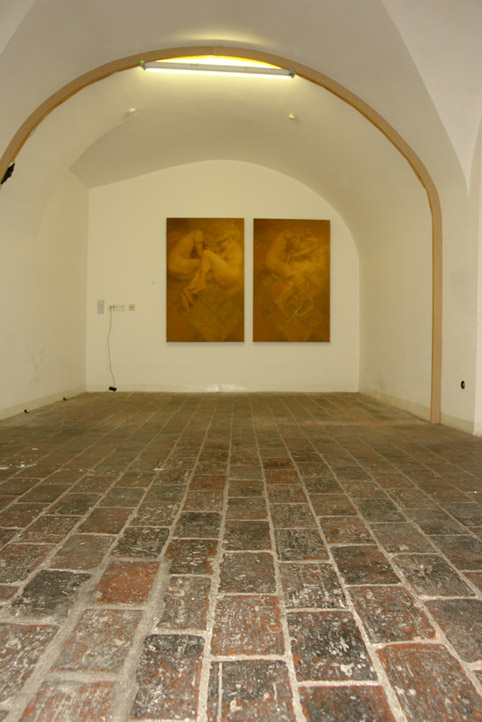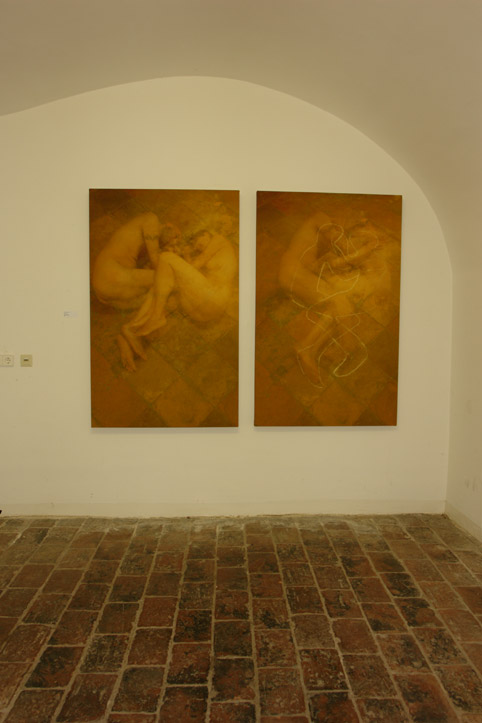“Archeologia",
Aktion I-XVI | 2006
deutsche Version <<
back to >> english version
  Archeologia, Aktion 9, 2006, 1.00x1.60 m, pigmentierte Tinte auf Leinwand | Archeologia, Aktion 10, 2006, 1.00x1.60 m, pigmentierte Tinte auf Leinwand |
|
Das
erste das mir auffiel war der Terracottaboden im Atelier, der sehr
schön ist. Er barg schon alles in sich, was mir erst später
in der Stadt bewusst wurde, die Archäologie der Zeit - die
Layer, die Landkarten, die Menschen, die Geschichte, die Gefühle.
Gertrude
Grossegger zur Arbeit „Archeologia“ von Eva Brunner-Szabo Gertrude
Grossegger about the work „Archeologia“ from Eva Brunner-Szabo Auszug aus einem Gespräch zwischen Eva Brunner-Szabo und Gerda Lampalzer über die Fotoarbeiten der Jahre 2005/06/07 geführt am 12.1.2007 G.L. Mich erinnern deine Arbeiten an archetypische Situationen wie die Pubertät, die Entjungferung, die Geburt, die Trennung und am Ende, wenn man alles durchgemacht hat, steht man da mit einem größeren Horizont und man kann einen neuen Anfang wahrnehmen. E.B. Die Fotografie ist für mich eine Art Katalysator, das war sie immer schon. Sie gibt mir die Möglichkeit, meine Gefühle, die oft nicht verbalisierbar sind, in Bilder zu fassen. G.L. Du beschreibst eine Gefühlswelt, aber immer im Wechsel zwischen Innen- und Außensicht. So erinnert mich „Fear in Pain“ an eine Verwandlung, etwas durchstoßen, etwas Brutales, auf alle Fälle zeigt die Arbeit einen Übergang von einem Zustand in den anderen. In Kombination mit der Bettszene im „Hotel Orient“ ergeben sich aber für diese Arbeit zwei Sichtweisen für mich, der voyeuristische Blick des Mannes aus „Hotel Orient“ steht im Gegensatz zur Sicht des Innenlebens der Frau in „Fear in Pain“. Durch die Kombination der beiden Arbeiten wird das formal nicht besonders gute Foto „Hotel Orient“ umorientiert auf eine feministische Sicht und bekommt dadurch eine ganz andere Bedeutung. Es ist mehr Hinweis für eine Leseart wie man Verbindungsfäden in den Arbeiten lesen kann. E.B. Es geht mir auch um die Darstellung von mehreren Sichtweisen. Ein Foto steht für mich nie alleine, es hat immer ein Davor und Danach. Fotografie ist für mich weit mehr als nur die Abbildung eines Motivs, sie ist eine Methode Gemütsfelder zu öffnen, oder auch Erkenntnisse, die ich durch die Fotografie gemacht habe, weiterzugeben – Gefühle, die das Leben bestimmen, wie Trauer, Wut, Liebe, Abschied, Schmerz, Geborgenheit. Ich glaube dadurch, dass ich sie zeige, werden sie übertragbar und bekommen so Symbolkraft auch für andere Menschen. G.L. Was mich
interessiert, ist die Art wie die Fotos entstehen? Dieses Arbeiten
in einer doppelten Rolle, Regisseurin und Modell in einem zu sein. G.L. Ich möchte
es mit kleinen Choreographien vergleichen, wo die Requisiten und
der Ort, d.h. die Stimmung ausgewählt wird und dann eine Performance
erfolgt, die einerseits kontrolliert ist durch die Vorgaben, aber
andererseits durch die Verwendung von Langzeitbelichtung und Stroboskopblitzen
extrem offen bleibt. Plane Two – Gerda Lampalzer (an extract from a conversation about the photographic works from 2005/06/07) G.L. Your works reminds me of archetypical situations like puberty, deflowering, birth, separation and at the end, when you have gone through all, your are at a broader horizon and a new beginning can be perceived. E.B. For me Photography is a kind of catalyst, it always has been. It allows me to turn my emotions which are not often being verbalised, into images. G.L. You describe a world of emotions always alternating between the inside and outside. “Fear and Pain” reminds me of a transformation, of penetrating something, something brutal, in any case the work shows a transition from one state into the next. Two viewpoints arise from the bed scene in “Hotel Orient”, the voyeuristic view of the man from “Hotel Orient” is placed in contrast to the view of the inner life of the woman in “Fear and Pain”. Through the combination of both works the not so well done photo “Hotel Orient” is re-orientated towards a feminist point of view and gains a completely different meaning. It is more like a comment of how to read connecting threads within the works. E.B. I am also concerned about the presentation of more than one viewpoint. A photo for me never stands alone, it always has a before and a after. For me photography is far more than the depiction of a motive, it is a method to open up fields of emotions, or even to pass on a realisation I have created through photography - emotions that form life, like mourning, rage, love, parting, pain, security. I believe that because I show them they are transferable and gain symbolic strength for other people. G.L. I am interested in how these photos develop? Working in a double role, director and model in one. E.B. The
working in a double role developed from my inner dispute between
intellect and emotion. For me the camera is the intellect and the
model is the emotion. In the moment of the production photography
can unify both. Therefore the work is something that frees me up,
as I can oppose to the emotion of sadness something real, like the
production of the situation for the camera. G.L. I like to compare this with small choreographies where requisite and place, e.g the emotion are chosen and then a performance happens which on the one hand, is controlled by the parameters, on the other hand remains extremely open by the use of long-term exposure and stroboscopic light E.B. That is right, I can only partially control the photo. As soon as I as the actor am alone or with my models in the setting, everything is open. As for Francis Bacon the canvas was a battlefield of chance and aggression, the photo studio is this for me. |
|